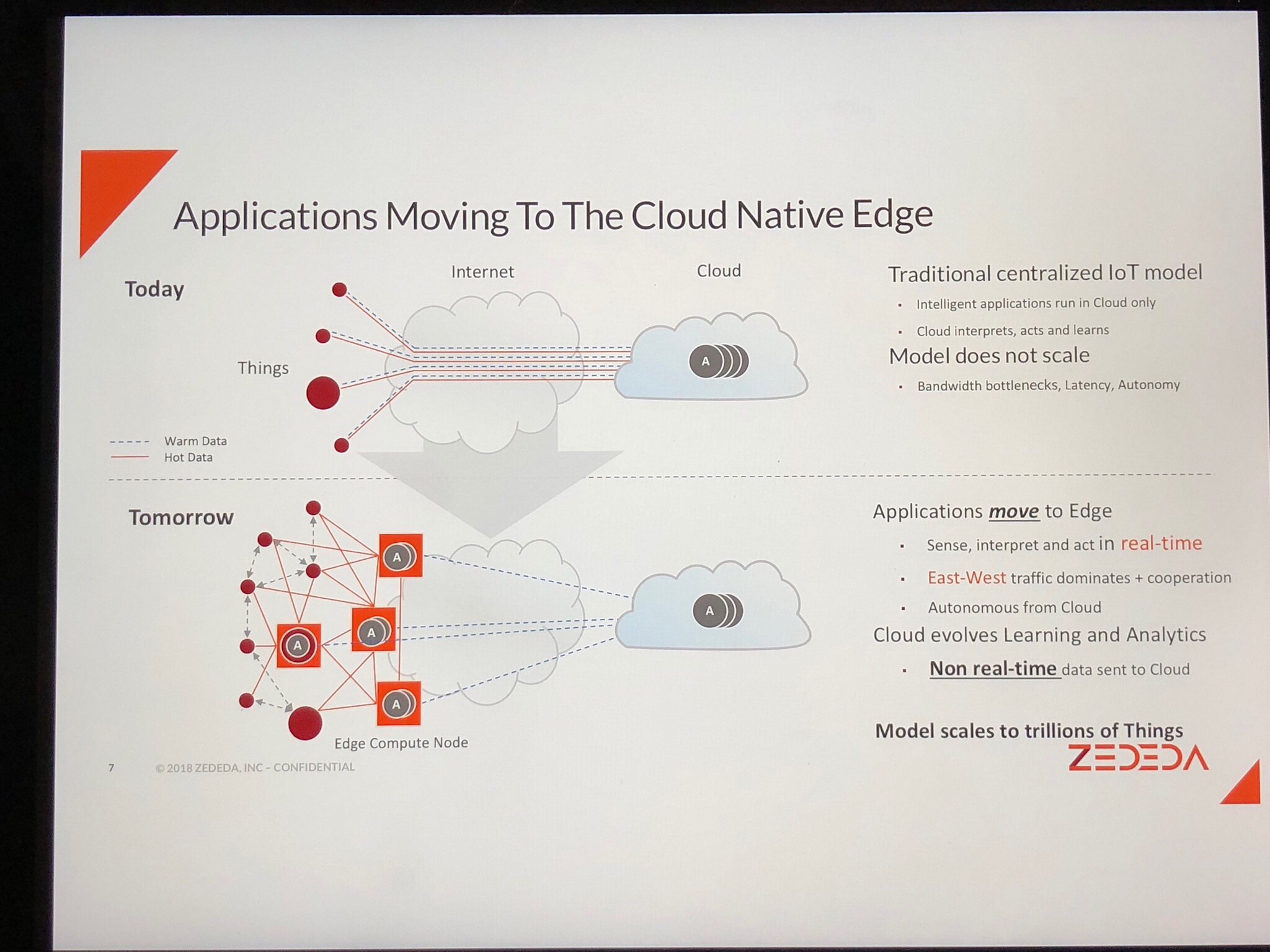The Internet of Things ecosystem is changing computing in almost a seismic shift. But like geology, it builds up over time and then the event happens before you know it.
We had centralized, on-site computing revolutionized by PCs. We networked PCs and wound up with centralized computing in the cloud. Demands from building the Internet of Things (or Industrial Internet of Things for us manufacturing and production geeks) expose the flaws of cloud computing. The next hot thing—edge.
Yesterday the CEO/co-founder of Zededa talked with me about the computing platform his company is building with no less a mission than to build the largest computing company on Earth without owning infrastructure. Its vision—create a new edge economy that allows applications to run anywhere.
Some of what follows may sound familiar. I’ve talked with many companies doing a piece of what Zededa has laid out, but none are as audacious as this.
In brief, Zedeta…
- Closes $3.06M in Seed Funding
- Pioneering a secure, cloud-native approach to real-time edge applications at hyperscale for solutions ranging from self-driving cars to industrial robots
- Built a team comprised of distinguished engineers from top tech companies in cloud, networking and open source to solve the edge computing puzzle and disrupt the status quo
- Seed round was led by Wild West Capital; other investors include Almaz Capital, Barton Capital and Industry Veteran Ed Zander, former CEO of Motorola and former COO of Sun Microsystems

“Tomorrow’s edge computing environment that enables digital transformation will be distributed, autonomous and cooperative. The edge is complex and not only has to scale out securely, but simultaneously must become friendlier for app developers. That’s the problem we are solving at ZEDEDA,” stated ZEDEDA CEO and Co-Founder Said Ouissal. “It will require a drastic shift from today’s embedded computing mindset to a more secure-by-design, cloud-native approach that unlocks the power of millions of cloud app developers and allows them to digitize the physical world as billions of ‘things’ become smart and connected.”
ZEDEDA will use the funding for continued research and product development, investment in community open-source projects for edge computing as well as further investment in sales and marketing initiatives. ZEDEDA investors include Wild West Capital and Almaz Capital, whose funding was part of a broader group investors, some of whom also invested in IoT/edge companies Theatro and Sensity Systems (now Verizon).
In the coming wave of pervasive computing, real-time apps, cyber-physical systems and data services such as machine learning and analytics will become commonplace. ZEDEDA envisions an open ecosystem and a completely new technology stack that creates a service fabric essential to achieving the hyperscale that will be required in edge computing.
To realize that goal, ZEDEDA has pulled together a distinguished roster of industry veterans from legendary technology companies with expertise in areas of operating systems, virtualization, networking, security, blockchain, cloud and application platforms. This unique blend of skills combines with the team’s deep connections to core open-source projects and standardization bodies. The team’s work has directly contributed to software and system patents as well as industry standards used by billions of people around the world today.
“A new paradigm and massive innovation is needed to meet demand for IoT and edge computing,” said Kevin DeNuccio, Founder of Wild West Capital and ZEDEDA’s lead investor. “Massive shifts in technology, including the proliferation of IoT, paves the way for industry disruption, which large incumbents tend to inhibit. Disruption takes a combination of an entrepreneurial team with a very unique set of collective experience, groundbreaking ideas, and the ability to garner immediate traction with global industrial leaders, who can transform their business with machine learning and artificial intelligence delivered by the Edge connected IoT world. ZEDEDA is simply one of the most promising edge computing startups out there.”
“Operations Technology teams face major challenges when it comes to fully realizing the advantages of an IoT world. Their worlds are becoming massively connected systems dealing with virtualization, networking and security,” stated Christian Renaud, Research Director, IoT at 451 Research. “Our recent research shows that while OT teams have the application plans for leveraging IoT, the vast majority of organizations’ IT resources and capabilities are maxed out. This leaves open the question of how these edge applications and IoT will scale out without compromising security or taxing resources even further in the future.”
Ouissal told me, “Edge is the next big wave, bigger than cloud, simply because of the sheer size of the number of devices. The goal is ubiquitous compute where applications want to interact real-time. The problem with the cloud is that it’s centralized. This ecosystem is truly Cyberphysical—just like your Industry 4.0.”
The current IoT model of sending all data to the cloud for processing, won’t scale due to:
- Bandwidth
- Latency
- Privacy issues
Three problems that the company is attacking:
1. Moving apps now running in the cloud to the edge
2. Edge-to-edge communication, key for autonomous systems, peer-to-peer
3. Security, cloud requires cyber security, but at the edge we must add physical security—someone could walk in and carry out an intelligent device
Ouissal often mentioned the need to rethink management of the edge. There exists a big difference between managing cloud and edge. Zedeta is tacking the variety of management challenges for updating and managing thousands to millions of embedded devices.
Solutions the team are developing include:
1. Security-built on platform, use keys, trusted, health check with every plug in, embedded virtualization
2. management-virtualization->can run multiple sessions on a device, eg robot motion on one session and analytics on another all on same embedded system, can scale this to millions of devices
3. Networking-monitor, watch lists, anomaly detection, analyze why, VPN architecture
This is all fascinating. I can’t wait to talk with competitors and potential competitors in a couple of weeks in Hannover and during some upcoming trips to get responses.





Trackbacks/Pingbacks